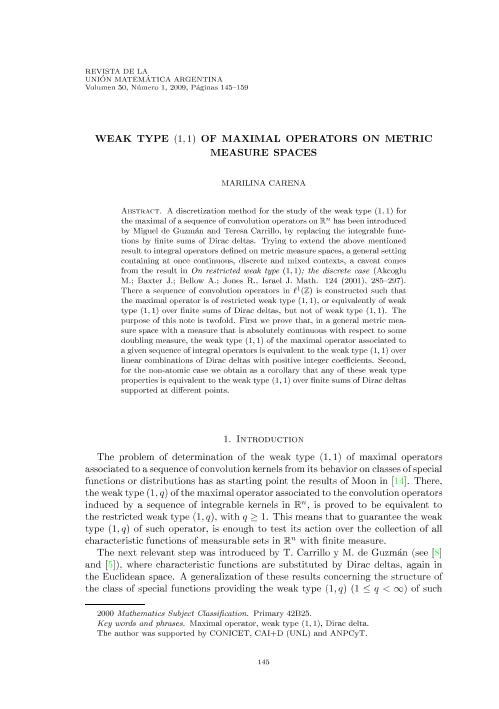Artículo
Weak type (1,1) of maximal operators on metric measure spaces
Fecha de publicación:
12/2009
Editorial:
Unión Matemática Argentina
Revista:
Revista de la Unión Matemática Argentina
ISSN:
0041-6932
e-ISSN:
1669-9637
Idioma:
Inglés
Tipo de recurso:
Artículo publicado
Clasificación temática:
Resumen
A discretization method for the study of the weak type (1,1) for the maximal of a sequence of convolution operators on R^n has been introduced by Miguel de Guzmán and Teresa Carrillo, by replacing the integrable functions by finite sums of Dirac deltas. Trying to extend the above mentioned result to integral operators defined on metric measure spaces, a general setting containing at once continuous, discrete and mixed contexts, a caveat comes from the result in "On restricted weak type (1,1); the discrete case" (Akcoglu M.; Baxter J.; Bellow A.; Jones R., Israel J. Math. 124 (2001), 285--297). There a sequence of convolution operators in $ell^1(Z)$ is constructed such that the maximal operator is of restricted weak type (1,1), or equivalently of weak type (1,1) over finite sums of Dirac deltas, but not of weak type (1,1). The purpose of this note is twofold. First we prove that, in a general metric measure space with a measure that is absolutely continuous with respect to some doubling measure, the weak type (1,1) of the maximal operator associated to a given sequence of integral operators is equivalent to the weak type (1,1) over linear combinations of Dirac deltas with positive integer coefficients. Second, for the non-atomic case we obtain as a corollary that any of these weak type properties is equivalent to the weak type (1,1) over finite sums of Dirac deltas supported at different points.
Palabras clave:
Maximal Operator
,
Weak Type (1,1)
,
Dirac Delta
Archivos asociados
Licencia
Identificadores
Colecciones
Articulos(IMAL)
Articulos de INST.DE MATEMATICA APLICADA "LITORAL"
Articulos de INST.DE MATEMATICA APLICADA "LITORAL"
Citación
Carena, Marilina; Weak type (1,1) of maximal operators on metric measure spaces; Unión Matemática Argentina; Revista de la Unión Matemática Argentina; 50; 1; 12-2009; 145-159
Compartir




